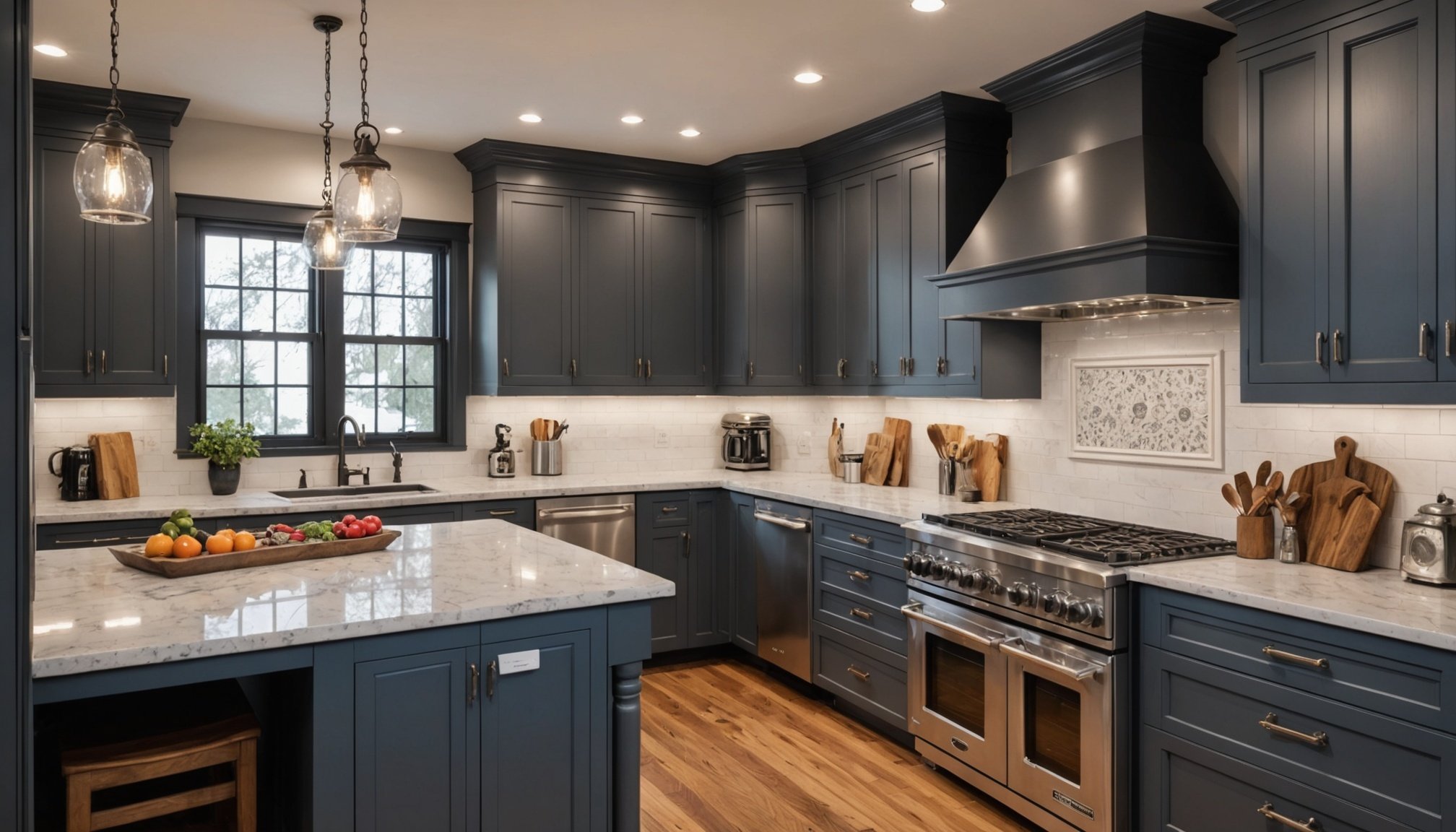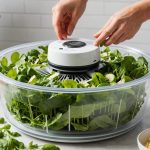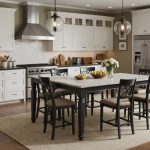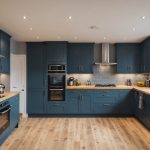Mastering Kitchen Design: Expert Tips to Effectively Minimize Cooking Odors
When it comes to designing a kitchen, one of the most critical aspects to consider is how to manage cooking odors. A well-designed kitchen not only enhances the aesthetic appeal of your home but also ensures a comfortable and healthy cooking environment. Here’s a comprehensive guide to help you minimize cooking odors and create a kitchen that is both functional and pleasant.
Understanding the Importance of Ventilation
Ventilation is the cornerstone of any kitchen design aimed at minimizing cooking odors. Proper ventilation systems are essential for removing odors, smoke, and excess heat from the kitchen.
Also to read : Mastering the Art of Kitchen Illumination: Creating a Flawless Harmony of Natural and Artificial Light
Range Hoods: The Heart of Kitchen Ventilation
Range hoods are vital appliances that play a crucial role in kitchen ventilation. There are two main types of range hoods: ducted and ductless.
-
Ducted Hoods: These hoods are connected to ductwork that channels contaminated air outside the building. They are highly efficient in removing odors and pollutants, making them a necessity in commercial kitchens and a preferred choice for many home kitchens. However, they require the installation of ducts, which can be more expensive.
In the same genre : Mastering UK Building Regulations: A Comprehensive Guide for Your Kitchen Renovation
-
Ductless Hoods: These hoods filter the air and recirculate it back into the kitchen. They are more flexible in terms of installation and can be placed in various locations, but they may not be as effective in removing odors and pollutants as ducted hoods.
Functional Testing and Maintenance
To ensure your ventilation system is working optimally, it's crucial to conduct regular functional tests.
- Turn on the ventilation system and check that the hood and ventilation fans work properly.
- Check for any strange noises, vibrations, or scents that might indicate a problem with the installation.
- Use a manometer or anemometer to confirm that airflow satisfies standards.
- Conduct a smoke test to ensure appropriate airflow and capture beneath the hood.
Designing Your Kitchen Layout for Optimal Ventilation
The layout of your kitchen is pivotal in ensuring that your ventilation system works effectively.
Assessing Your Kitchen Size and Layout
The size and layout of your kitchen will determine the type and capacity of the ventilation system you need.
- Kitchen Size: Larger kitchens may require multiple hoods or stronger ventilation systems to adequately remove contaminants.
- Cooking Equipment: The type of cooking equipment you use will influence the ventilation needs. For example, high-heat appliances like commercial stoves require more powerful ventilation.
Work Triangle and Layout Considerations
The work triangle concept is a classic design principle that can help optimize your kitchen layout for better ventilation.
- Work Triangle: This concept involves positioning your sink, stove, and refrigerator in a triangular formation to minimize walking distances and improve workflow. Ensuring that your range hood is centrally located within this triangle can enhance its effectiveness.
Example Layouts
Here are a few common kitchen layouts and how they can be optimized for ventilation:
| Kitchen Layout | Ventilation Considerations |
|---|---|
| L-Shaped Kitchen | Place the range hood above the stove, ensuring it is centered and away from any obstructions. |
| U-Shaped Kitchen | Use a more powerful range hood to cover the larger cooking area. |
| Island Kitchen | Install a ductless hood if ductwork is not feasible, or use a ducted hood with careful planning to ensure proper duct installation. |
Choosing the Right Appliances and Storage Solutions
The appliances and storage solutions you choose can significantly impact the air quality in your kitchen.
High-Quality Appliances
Investing in high-quality appliances, especially those with built-in ventilation features, can make a big difference.
- Range Hoods with Advanced Filters: Look for range hoods with high-efficiency filters that can capture grease, smoke, and odor particles effectively.
- Ovens and Stoves: Choose appliances with good ventilation options, such as convection ovens that distribute heat evenly and reduce cooking odors.
Storage Solutions
Proper storage can help reduce clutter and improve airflow in the kitchen.
- Modular Kitchen Storage: Use modular cabinets and drawers to keep cooking utensils and ingredients organized, reducing the likelihood of spills and messes that can contribute to odors.
- Open Shelving: Incorporate open shelving for frequently used items, but ensure they are easy to clean to prevent grease and dust buildup.
Lighting and Interior Design
Lighting and interior design elements can also play a role in maintaining a fresh and odor-free kitchen.
Lighting Ideas
Adequate lighting can help in maintaining a clean and well-ventilated kitchen.
- Natural Light: If possible, position your kitchen to maximize natural light. This can help in reducing the need for artificial lighting and improving air quality.
- Task Lighting: Use task lighting above cooking areas to highlight any spills or messes that need immediate attention.
- Ambient Lighting: Ambient lighting can create a welcoming atmosphere while also helping to illuminate areas that might otherwise be overlooked.
Interior Design Tips
The interior design of your kitchen can influence how well your ventilation system works.
- Color Scheme: Choose a color scheme that is easy to clean and maintain. Lighter colors can make the kitchen appear more spacious and easier to clean.
- Materials: Use materials that are resistant to grease and moisture, such as stainless steel or ceramic tiles, for countertops and backsplashes.
Practical Insights and Actionable Advice
Here are some practical tips to help you minimize cooking odors in your kitchen:
Regular Maintenance
Regular maintenance is key to ensuring your ventilation system works efficiently.
- Clean the Range Hood: Regularly clean the range hood, filters, and ductwork to prevent grease buildup.
- Check for Obstructions: Ensure that there are no obstructions in the ductwork or around the range hood that could impede airflow.
Use of Air Purifiers
Air purifiers can be a useful addition to your kitchen ventilation system.
- Air Purifiers: Consider using air purifiers to filter out pollutants and odors from the air, especially in kitchens with limited ventilation options.
- Open Windows: When possible, open windows to allow fresh air to circulate through the kitchen.
Communication with Professionals
Working with experienced professionals can help you design and install a customized ventilation system.
- Consult Experts: Consult with kitchen ventilation professionals to assess your kitchen layout and cooking equipment to develop a tailored ventilation solution.
- Local Regulations: Ensure that your ventilation system complies with local building codes and regulations to avoid fines and potential shutdowns.
Designing a kitchen that effectively minimizes cooking odors involves a combination of proper ventilation, thoughtful layout planning, and the right appliances and storage solutions. By understanding the importance of ventilation, designing your kitchen layout with ventilation in mind, choosing high-quality appliances, and maintaining your kitchen regularly, you can create a kitchen that is not only functional but also a pleasant space to cook and live in.
Final Tips
- Consider Your Needs: Tailor your kitchen design to your specific cooking needs and the size of your kitchen.
- Invest in Quality: Invest in high-quality appliances and materials that are easy to clean and maintain.
- Maintain Regularly: Regular maintenance is crucial to ensuring your ventilation system works optimally.
By following these expert tips, you can master the art of kitchen design and create a space that is free from cooking odors, making your home a more comfortable and enjoyable place to live.











